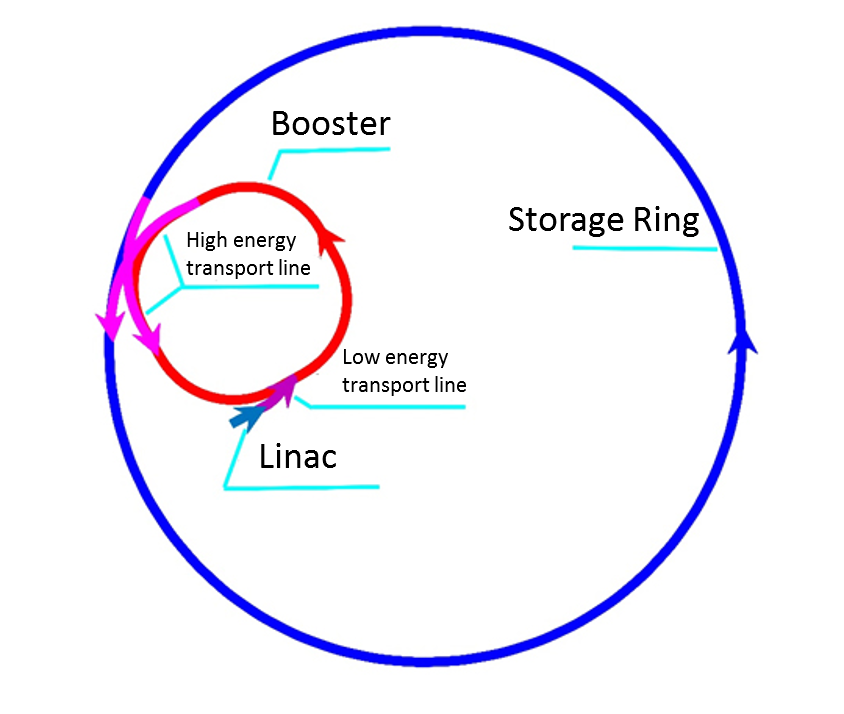The accelerator is the main part of the light source and is responsible for providing high quality synchronized light for the beam lines. The HEPS accelerator consists of three separate accelerators, the storage ring, the booster and the linear accelerator, and three transport lines connecting the three accelerators. The structure of the HEPS accelerator is shown in figure 1.

Figure 1 the layout of HEPS storage ring, booster, linac and transport lines
The storage ring
The main part of the HEPS accelerators is an ultra-low emission electron storage ring with the circumference of 1360.4m, the beam energy of 6GeV and the maximum current strength of 200mA. The electronic storage ring consists of 48 modified hybrid 7BA units to achieve a horizontal natural emittance of less than or equal to 60pm?rad. The hardware system of the storage ring mainly includes magnet system composed of dipoles, quadrupoles, hexapoles, octupoles, independent correctors and alignment coils, and power supply system In addition, the hardware system is also composed of vacuum system, high frequency system (basic frequency and triple frequency system), beam instrumentation system, injection and extraction system, insert device system, control system, and the girders of various components.
The Booster
The booster is an electron synchrotron accelerator and a full energy injector for the storage ring with the circumference of about 454.5m. It adopts fourfold symmetrical FODO magnetic focusing structure. It is composed of magnet system, power supply system, high-frequency system, vacuum system, mechanical engineering system, control system and beam instrumentation system. It can help accelerate the speed of electron beam from 500MeV to 6GeV. When the beam energy was accelerated to 6GeV, the booster can help to merge the beams that were injected back from the storage ring with the beams with raised energy to accumulate the charge. After the completion of the charge accumulation, the booster reinjects the beams into the storage ring to achieve the beam intensity required for the storage ring to operate.
Linac
The linac is an injector for the booster, with a total length of about 49m. It is constructed with hot-cathode electron gun of long life and high stability, conventional bunching system with mature technology, s-band gradient traveling-wave acceleration structure at room temperature, power source system, microwave amplitude and phase control system and so on. The output beam energy of the linac is 500MeV. Its macro pulse repetition frequency is 50Hz, and the half-height and full-width of the linac accelerator are 1.1ns. In addition, its design charge is 7nc.
Low energy transport lines
The low-energy transmission line is about 25m long. In addition to connecting the linear accelerator and the booster, it can also transfer deliver beams of 500MeV from the linear accelerator to the booster.
High energy transport line
HEPS has two 105-meter high energy transport lines of similar structures. One of them extracts beams from the storage ring and re-injects them into the booster to converge with beams of escalated energy in the booster. The other transfers the converged beams to the storage ring.
|
Parameter |
Design index |
Acceptance index |
|
Storage ring circumference(m) |
1360.4 |
|
|
Enhancer circumference(m) |
454.5 |
|
|
Lattice structure |
48×7BA |
|
|
Energy(GeV) |
6 |
6 |
|
Current strength(mA) |
200 |
100 |
|
Beam emittance(nm·rad) |
0.06 |
0.1 |
|
Brightness(phs/s/mm2/mrad2/0.1%BW) |
>1×1022 |
2×1021 |
Construction difficulties
As HEPS storage ring aims to achieve the horizontal natural emittance lower than 0.06nm·rad, it is designed with the improved hybrid 7BA structure. This structure requires ultra-high strength quadrupole magnet and hexapole magnet, as a result of which, the dynamic aperture is small and sensitive to errors. Moreover, the sharp decline in horizontal length of beams demands more beam location stability. All these factors greatly increases the difficulty in design, construction and operation, as the followings show in details:
(1) The collimation accuracy of main magnet should be better than 20μm to reduce the influence of installation errors. Delicate magnet design and super high machining accuracy are needed to achieve ultrahigh strength and good fields. Ultra high magnet power supply stability should be better than 10ppm.
(2)Ultrahigh strength hexapole magnetic field has a strong nonlinear effect, making the dynamic aperture of storage ring too small to implement the traditional off-axis injection method. Therefore, it needs to develop a high-precision, short-pulse in-axis injection system. Moreover, the high energy charge accumulation and recycling are also two difficulties.
(3)The horizontal length of beams for the light source point (especially in the vertical direction) is often about 1μm. However, the position stability of light source point needed by the customer is better than 10% of beam horizontal length, i.e. achieving the stability on the level of 0.1μm. This is not only demanding for beam position measurement system and fast track feedback system, but also asks for a special process for the accelerator tunnel foundation to eliminate the effects of micro-vibration on the beams.
